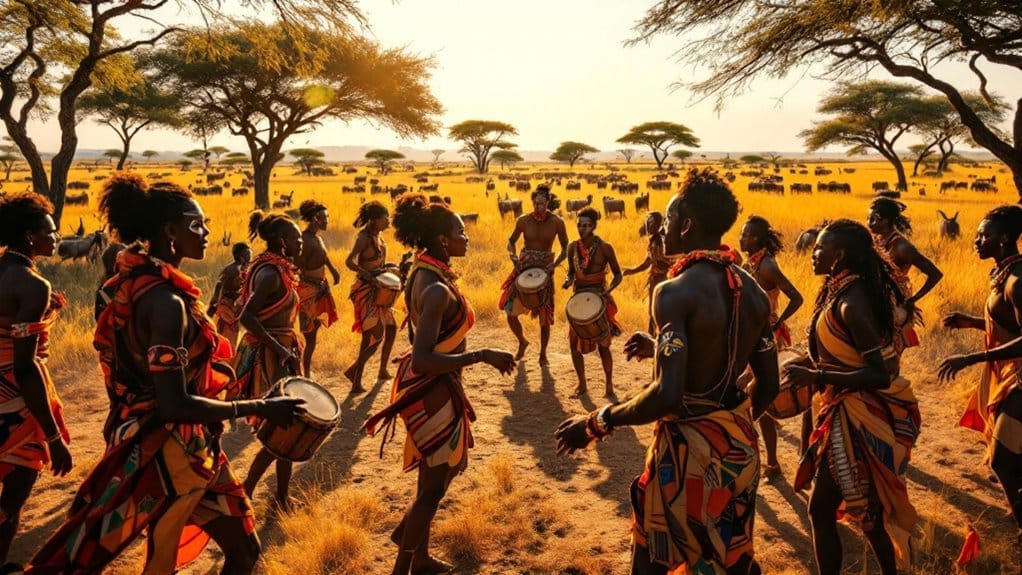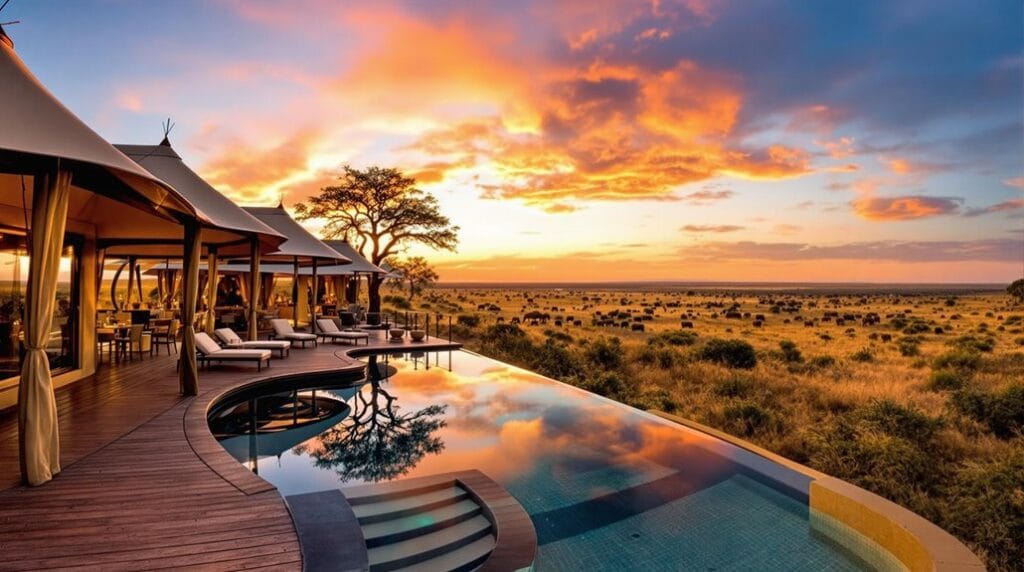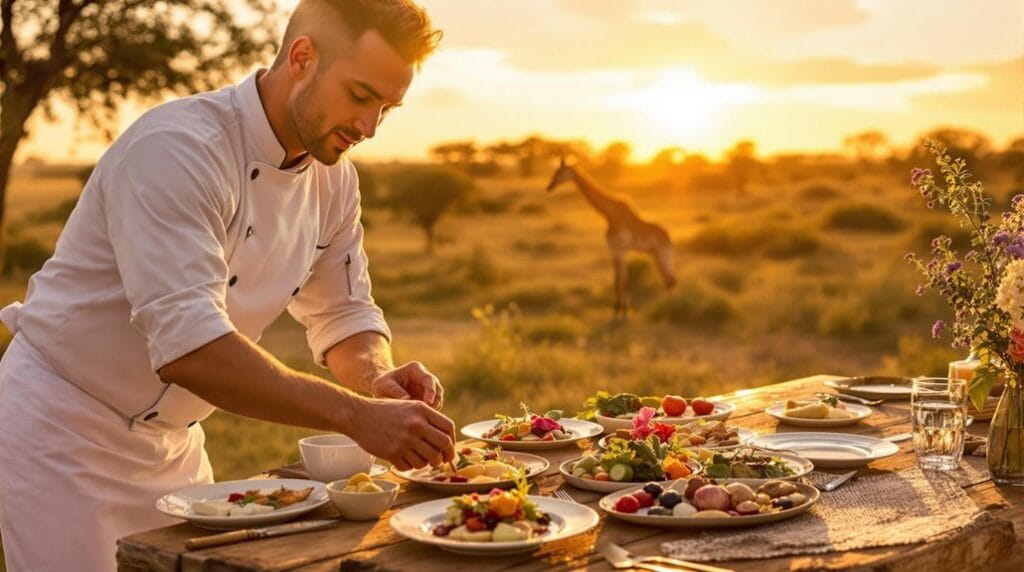On your safari adventure, you'll encounter vibrant traditional rituals that breathe life into Africa's rich cultural tapestry. Witness the Maasai Warrior initiation, where bravery and community spirit come alive through spirited jumping dances. Experience the Himba fertility rituals that celebrate lineage with communal dances and offerings. Participate in the San Healing Dance, connecting with ancestral spirits through rhythmic movements. Marvel at the Zulu Reed Dance, a celebration of purity and cultural pride. These experiences, along with vibrant festivals and unique customs, immerse you deeply in Africa's heritage, teasing the cultural treasures that await you around each bend.
Key Takeaways
- Experience the Maasai Warrior Initiation Ceremony, where jumping dances highlight bravery and cultural identity amidst the backdrop of a safari adventure.
- Participate in the Zulu Reed Dance, celebrating purity and unity through energetic performances that reinforce cultural values during your safari exploration.
- Witness Karo scarification traditions, showcasing intricate body art that communicates social standing and tribal affiliation, enriching your understanding of local cultures.
- Engage in Hadza Celebrations, where skill demonstrations and traditional music connect you to sustainable practices and the community's bond with nature.
- Enjoy the Nyau Brotherhood Mask Dances, which convey moral lessons and preserve Chewa cultural heritage through captivating performances during your safari journey.
Maasai Warrior Initiation Ceremony
The Maasai Warrior Initiation Ceremony, often referred to as the Adamu, is a vibrant and powerful rite that frequently captivates those who witness it. This ceremony marks a significant change for young male warriors, who demonstrate their strength and agility through a stunning jumping dance.
You'll see up to twelve warriors competing in leaping contests, their bodies soaring high against the backdrop of traditional chants and war cries that echo the spirit of their community.
As the warriors don colorful shuka garments, the bold red signifies both sacredness and bravery, deeply woven into their cultural identity. This isn't just a display of physical prowess; it reinforces the importance of protecting cattle, a cornerstone of Maasai life.
The Adamu ceremony fosters a sense of belonging, binding participants and spectators alike in a shared cultural pride.
Watching the jumping dance, you can feel the energy of the age-set system come alive, highlighting social bonds that unite the Maasai community.
The Adamu isn't merely a rite of passage; it's a celebration of heritage, strength, and the enduring spirit of a people committed to preserving their traditions.
Himba Fertility Rituals
When you explore the Himba tribe's fertility rituals, you'll notice how deeply they value the continuity of their lineage.
These ceremonies, marked by the application of otjize and communal dances, serve not just as a means to enhance fertility but also as an essential expression of cultural identity.
Cultural Significance of Fertility
Celebrating fertility within the Himba tribe of Namibia involves a rich tapestry of rituals that underscore the deep cultural significance placed on childbirth and lineage. Here, fertility isn't just a personal matter; it's a communal bond, woven through collective efforts and shared traditions.
Women engage in rituals that often include offerings to ancestors and prayers, believing these acts invoke ancestral blessings essential for conception.
As you partake in these vibrant rituals, you'll notice the rhythmic pulse of traditional music, which enhances the spiritual ambiance and reinforces the tribe's connection to their heritage. The application of otjize—a mixture of ochre and butter—becomes a symbol of beauty and health, reflecting the Himba's belief in the physical aspects of fertility.
In this culture, every birth is celebrated as a communal event, emphasizing the shared responsibility of raising the next generation. This celebration fosters social bonds, reinforcing the idea that each child isn't just an individual but a continuation of the tribe's legacy.
Through these practices, you'll feel the heartbeat of the Himba, where fertility signifies life's continuity and the interconnectedness of community and ancestry.
Rituals and Practices Explained
Rituals of fertility within the Himba community embody a profound connection to both ancestry and nature, reflecting the crucial role women play in nurturing life. These fertility rituals are not just practices; they are fundamental expressions of cultural identity and communal strength. Women gather to seek blessings from their ancestors, invoking protection and guidance through song, dance, and the use of natural elements like ochre and butter.
| Element | Purpose | Symbolism |
|---|---|---|
| Offerings to Ancestors | Invoking blessings | Connection to heritage |
| Traditional Songs | Celebrating womanhood | Strengthening community bonds |
| Natural Materials | Enhancing beauty & identity | Reflection of fertility |
During these communal gatherings, stories of childbirth and motherhood flow, creating a tapestry of shared wisdom that reinforces social ties. Each ritual highlights the Himba Tribe's deep-rooted spirituality and respect for nature, illustrating how these practices maintain the well-being of future generations. By participating in these rituals, you not only witness a vibrant cultural heritage but also feel a sense of belonging to something larger than yourself.
San Healing Dance
As you witness the San Healing Dance, you can't help but feel the energy of the community as rhythmic movements and clapping create a powerful atmosphere.
This trance-inducing ceremony connects participants with ancestral spirits, offering a profound sense of belonging and healing from ailments like "star sickness."
The dance not only showcases the San people's deep spiritual knowledge but also reinforces their cultural identity and social bonds, making it an essential expression of their heritage.
Trance-Inducing Ceremonial Practices
While many cultures engage in ceremonies to connect with the spiritual sphere, the San Healing Dance stands out for its profound emphasis on communal participation and ancestral connection. This all-night ritual invites you to witness how participants chant and engage in rhythmic movements, transcending into trance-inducing states that foster healing and unity.
The dance serves not just as a method of addressing mental health issues—like "star sickness"—but as a vibrant expression of the San people's cultural identity. Each movement and song resonates with their rich storytelling traditions, reinforcing social bonds within the tribe.
Here's a glimpse into the core elements of the San Healing Dance:
| Element | Description | Significance |
|---|---|---|
| Communal Participation | Involves everyone, creating a sense of belonging | Strengthens social bonds |
| Rhythmic Movements | Body movements synchronized with chants | Induces trance states |
| Ancestral Connection | Invokes spirits for healing guidance | Deepens spiritual ties |
Through these trance-inducing practices, the San people showcase their ecological knowledge and cultural resilience, inviting you to explore the deeper connections between nature, community, and the spiritual sphere.
Connection With Ancestral Spirits
The San Healing Dance embodies a profound connection with ancestral spirits, inviting participants to engage in a sacred experience that transcends the physical domain.
As you immerse yourself in this all-night ceremony led by healers, you'll discover the depth of African cultures and the essential role of community in healing.
During the dance, four key elements come into play:
- Chanting: The rhythmic chants guide participants into a shared spiritual journey.
- Breathwork: Intentional breathing techniques help you reach trance-like states, enhancing your connection with the ancestral spirits.
- Movement: The dynamic dance fosters a sense of unity and shared purpose among participants.
- Storytelling: Through oral traditions, you'll learn about the wisdom passed down through generations.
This unique ritual not only addresses mental and physical ailments but also strengthens community bonds, emphasizing the San people's profound relationship with nature.
Cultural Significance of Healing
Few rituals resonate with the cultural fabric of the San people like the Healing Dance, a vibrant expression of their collective identity and spiritual beliefs. This all-night ceremony acts as a conduit, connecting participants not only with ancestral spirits but also with each other, reinforcing their shared heritage.
As you witness skilled healers guiding the dance, you'll notice how their chanting and rhythmic movements create a pulsating energy that induces trance-like states. The San Healing Dance is more than a therapeutic practice; it embodies a crucial cultural expression that emphasizes community ties.
Through dynamic movements, participants symbolize the integration of body, mind, and spirit, reflecting the holistic principles of San healing traditions. Each step is a reflection of their commitment to mental and physical healing, addressing contemporary challenges while honoring ancestral wisdom.
Moreover, this ritual serves as a living archive, preserving and transmitting cultural knowledge across generations. By engaging in the Healing Dance, you become part of a communal narrative, contributing to the ongoing legacy of the San people and their enduring connection to the spirit world.
Embracing this experience fosters a sense of belonging that transcends time and space.
Karo Scarification Traditions
Throughout generations, the Karo tribe of Ethiopia has embraced scarification as a profound expression of beauty and identity. This practice, particularly among women, involves carving intricate patterns into the skin, symbolizing maturity and social status. Scarification rituals aren't merely aesthetic; they weave together personal and communal narratives.
Here are some key aspects of Karo scarification traditions:
- Cultural Significance: Scarification is performed during important life events, connecting individuals to their ancestral heritage.
- Artistry: Sharp tools are used to create designs that can take years to heal, resulting in raised scars that are celebrated for their beauty.
- Identity Communication: These scars convey essential messages about one's social standing, individual identity, and tribal affiliation within the community.
- Resilience: The Karo tribe's commitment to scarification showcases their artistry and cultural resilience amid modernization.
As you explore the Karo tribe's rich cultural landscape, you'll find that scarification is more than skin-deep. It's a powerful reflection of their enduring identity and social bonds, inviting you to appreciate the beauty of their traditions.
Zulu Reed Dance
As you witness the Zulu Reed Dance, you'll feel the powerful significance it holds for the community, celebrating purity and cultural pride among young women.
The vibrant attire, adorned with intricate beads and symbols, tells stories of heritage and tradition, while the rhythmic movements of the dancers draw you into a collective display of unity and cultural identity.
This annual ceremony not only honors the values of the Zulu people but also invites you to reflect on the deeper meanings woven into their rich tapestry of rituals.
Significance of the Dance
Amidst the vibrant colors and rhythmic movements of the Zulu Reed Dance, you'll find a profound celebration of culture and identity that resonates deeply within the community.
This annual event, known as Umkhosi woMhlanga, holds significant meaning as it promotes cultural pride among young unmarried women.
As you observe, you'll notice several essential elements that highlight its importance:
- Celebration of Purity: The dance honors young women, encouraging them to embrace their heritage and values.
- Symbolic Reeds: Participants gather reeds from the river, presenting them to the Zulu king as a commitment to their culture.
- Unity in Dance: The energetic performances showcase the strength of womanhood, uniting participants in a shared cultural identity.
- Community Engagement: Attracting thousands of spectators, the event fosters a spirit of belonging, allowing the king to empower the youth.
As you witness this celebration, you'll feel the energy that binds the community together, reinforcing moral values and discouraging premarital relationships.
The Zulu Reed Dance isn't just a spectacle; it's a meaningful expression of cultural pride and identity, deeply rooted in tradition.
Cultural Attire and Symbols
The Zulu Reed Dance is not just a vibrant spectacle of movement and music; it's also a visual tapestry woven from the rich cultural heritage of the Zulu people. As you witness this annual event, you'll notice the intricate cultural attire worn by the young Zulu women, symbolizing beauty, purity, and their important role within the community.
| Cultural Attire | Symbolism |
|---|---|
| Colorful bead skirts | Celebration of virginity |
| Animal hides | Social status |
| Beaded necklaces | Cultural identity |
| Woven reeds | Purity and femininity |
| Traditional headpieces | Respect and honor |
During the dance, participants gather reeds from the river, each one a symbol of their commitment to preserving Zulu culture. The event, held in September as spring dawns, is a celebration that resonates with music and rhythm, pulling you into a world that values community and heritage. The king's acceptance of the reeds further underscores the importance of these practices in maintaining cultural ties. You'll find that the attire worn during the Reed Dance tells a story, inviting you to connect with the profound traditions of the Zulu people.
Xhosa Initiation Rituals
Xhosa initiation rituals, particularly Ulwaluko, stand as a profound demonstration of cultural heritage and communal identity. This rite of passage for boys marks their progression into manhood, enveloping them in a rich tapestry of tradition and education.
As you explore this transformative experience, you'll discover key elements that shape their journey:
- Seclusion in the Mountains: Initiates spend weeks away from society, engaging in spiritual guidance and learning.
- Circumcision Ceremony: Performed by a designated elder, this act symbolizes physical and spiritual cleansing.
- Cultural Practices: Traditional songs and dances accompany the process, fostering community bonds and shared wisdom from elders.
- Umgidi Celebration: After the initiation, a vibrant ceremony welcomes the boys back, celebrating their new status as men.
These Xhosa initiation rituals are more than mere customs; they weave the fabric of cultural identity, reinforcing social order and continuity within the tribe.
As you witness these profound traditions, you'll feel a sense of belonging that transcends generations, connecting you to the essence of Xhosa life. Embracing these rituals is an invitation to understand the depth of their cultural landscape.
Samburu Elders' Blessing
As you continue your exploration of African cultural rituals, the Samburu elders' blessing stands out as an essential experience for travelers commencing on safari adventures. This ritual is deeply rooted in the Samburu culture, reflecting their profound respect for ancestral guidance.
As you gather with the community, you'll witness the elders chanting traditional prayers, their voices harmonizing with the rhythm of the land. You'll feel the weight of history and spirituality enveloping you.
During the ceremony, you'll be anointed with sacred herbs or water, symbols of purification and spiritual preparation for your journey. Adorned in vibrant Samburu attire, you'll see how the intricate beadwork celebrates cultural identity, making you feel part of something larger.
This isn't just a blessing; it's an invitation to engage with the values and practices that bind the Samburu people to their environment. The blessing highlights the interconnectedness of community, spirituality, and nature, reminding you of the harmony essential for a fulfilling safari experience.
Embracing this ritual enriches your adventure, fostering a sense of belonging within the vibrant tapestry of Samburu culture.
Hadza Foraging Celebrations
During your journey through Tanzania, immersing yourself in the vibrant foraging celebrations of the Hadza people offers a unique glimpse into their rich cultural heritage.
These gatherings are more than just communal feasts; they embody the essence of their identity and connection to the land. Here are some key aspects of these foraging celebrations:
- Skill Demonstrations: Watch as tribe members showcase their mastery in tracking animals and identifying edible plants, honing skills passed down through generations.
- Cultural Transmission: Elders share essential knowledge about sustainable practices and the seasonal availability of resources, ensuring the wisdom of the past shapes the future.
- Music and Dance: Experience the infectious rhythms and movements that celebrate their deep connection to nature, reflecting the spiritual significance of their surroundings.
- Community Bonding: Witness the emphasis on sharing food and resources, reinforcing the importance of communal living and collective experiences.
These foraging celebrations not only sustain the Hadza people but also serve as a powerful reminder of the rich tapestry of culture and community that thrives in Tanzania.
Engage with their traditions, and you'll find a profound sense of belonging.
Nyau Brotherhood Mask Dances
The Nyau Brotherhood Mask Dances offer an enchanting window into the cultural richness of the Chewa people of Malawi, where each performance bursts with meaning and artistry.
These dances, integral to Chewa society, embody the spirit and beliefs of a community that values tradition and connection. As you watch, you'll notice the intricate masks that represent ancestral spirits, animals, and symbolic figures, each crafted with care and imbued with distinct meanings.
The Nyau Brotherhood serves as a secret society, with members undergoing rigorous training to master the art of dance while swearing to uphold the society's secrecy. This mystique adds an air of respect and reverence, drawing you deeper into the experience.
The dances aren't mere entertainment; they convey moral lessons, preserve cultural heritage, and reinforce social order during significant events like funerals and initiation ceremonies.
As performers move gracefully, they weave stories that resonate with the audience, fostering a sense of belonging and shared identity.
Through the Nyau dances, you connect not just with the artistry but also with the enduring spirit of the Chewa people, a community rich in tradition and purpose.
Cultural Festivals of Africa
Africa's cultural festivals are vibrant celebrations that offer an enchanting glimpse into the continent's diverse traditions and communal values. By attending these events, you can experience the essence of African heritage firsthand.
Here are a few notable festivals that embody this spirit:
- Kuomboka Festival (Zambia) – Witness the king's majestic journey on the royal boat Nalikwanda each March, a representation of the community's rich cultural heritage.
- Lamu Cultural Festival (Kenya) – Every November, immerse yourself in Swahili culture through henna painting, donkey races, and traditional poetry, preserving local customs.
- Maasai Jumping Dance (Adamu) – Participate in this exhilarating display of agility and strength, connecting you to the Maasai community and their vibrant traditions.
- Dance Forms at Lamu – Experience the Kirumbizi and Taarab, which not only keep oral traditions alive but also serve as platforms for social commentary within the community.
These cultural festivals provide essential opportunities for immersion and connection, inviting you to share in the joy and unity of African communities.
Frequently Asked Questions
What Are African Tradition Rituals?
African traditional rituals embody cultural significance and spiritual practices, connecting you to community and ancestors. Through rites of passage and healing ceremonies, you experience a rich tapestry of beliefs that foster belonging and cultural continuity.
What Is the Best Traditional Ceremony in Africa?
When you explore Africa's best traditional ceremonies, you'll discover rich cultural significance in vibrant ceremonial attire, from the mesmerizing Kuomboka Festival to the enchanting Wodaabe gerewol, each showcasing community, heritage, and the beauty of tradition.
What Is the Most Respected Tribe in Africa?
When you explore Africa's rich tapestry, you'll find tribes like the Maasai and Zulu, each holding immense cultural significance. Their tribal hierarchy reflects deep-rooted traditions that foster community, respect, and a sense of belonging.
What Is the Most Beautiful African Tribe?
When you explore Africa's tribal aesthetics, you'll find beauty in cultural diversity. Each tribe, from the Himba to the Maasai, expresses unique identities through art, attire, and traditions, enchanting all who seek deeper connections.
Conclusion
As you commence your safari adventure, you might think you're just chasing wildlife. Ironically, the true essence of Africa lies not in the elusive big cats, but in the vibrant rituals that pulse beneath the surface. Each ceremony offers a glimpse into the heart of diverse cultures, revealing connections that transcend the wild beasts. So, while you thrill at the sight of a lion, don't overlook the richness of human tradition that surrounds you—it's often more enchanting than the savanna itself.








